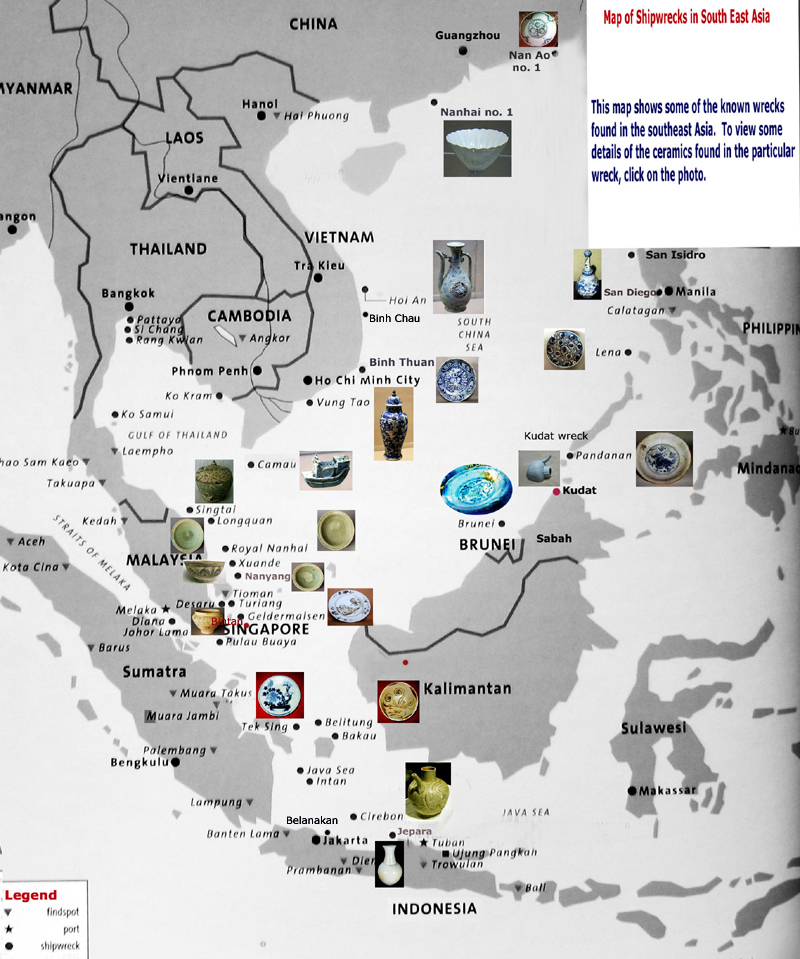
Shipwrecks with Ceramics cargo found in Southeast Asia
To view details of a wreck, click on the photo of the vessel

The earliest records of Chinese contact with Southeast Asia date back to the Han Dynasty. Chinese porcelains—renowned for their durability—serve as evidence of a long history of trade and cultural exchange. These porcelains were traded for spices, aromatics, kingfisher feathers, rhinoceros horns, pearls, and other exotic goods. In Southeast Asia, Chinese ceramics were highly valued, often kept as family heirlooms and used as funerary objects. Many such items have been excavated and are now housed in museums and private collections.
Maritime trade was a lucrative endeavor, but it also carried great risks. Merchants and sailors faced storms, fires, piracy, and dangerous reefs—many perishing at sea. Over more than two millennia, the South China Sea has become a vast graveyard for countless shipwrecks.
The high commercial value of ancient ceramics has driven both legal and illegal salvage operations. One of the most famous recoveries was the Nanking (Geldermasen) cargo, which was auctioned with remarkable success at Christie's in Amsterdam in 1986, sparking global interest in shipwreck ceramics. Since then, ceramics from wrecks such as the Ming-period Binh Thuan and Hatcher wrecks, and the Qing-period Ca Mau, Vung Tau, Diana, and Tek Sing wrecks have also been successfully auctioned by major international houses.
While concerns remain about improper excavation methods, these discoveries have provided valuable insights into ancient trade ceramics.
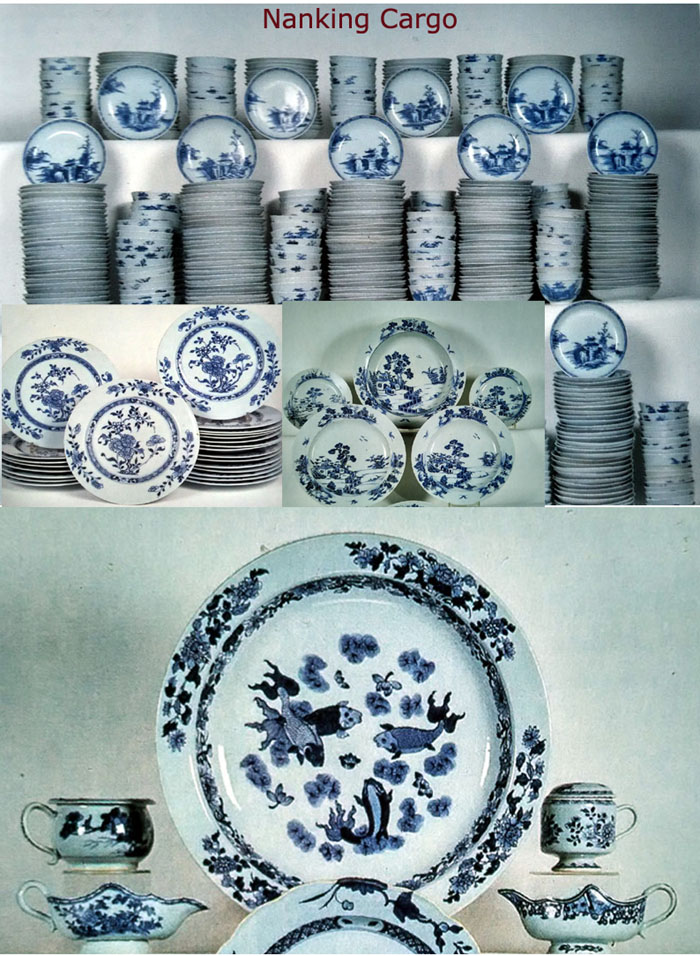 |
| Jingdezhen ceramics in Nanking Cargo |
The most significant discovery from this period is the 9th-century Belitung wreck, found near the Bangka-Belitung Islands off Sumatra in 1998. German treasure hunter Tilman Walterfang recovered over 60,000 artifacts, including Changsha wares, Xing white wares, Yue/Guangdong green wares, three rare blue-and-white pieces, gold vessels, coins, and glassware. In 2005, the collection was sold to the Singapore government for US$32 million.
In 2013, another late 9th-century Tang wreck was discovered at Binh Chau (Chau Tan) in Quang Ngai Province, central Vietnam. Its cargo resembled that of the Belitung wreck, featuring Changsha polychrome painted wares, Xing white wares, and Yue/Guangdong green wares. Excavations suggest the vessel was a Southeast Asian ship, highlighting the involvement of Arab and Persian merchants in maritime trade.
In 2019, an early 9th-century Tang wreck was found near Ba Ria, southern Vietnam. Its cargo bore similarities to that of the Belitung wreck, though white wares predominated. This wreck is notable for its lead green and amber-glazed dishes and cups with Islamic-influenced designs.
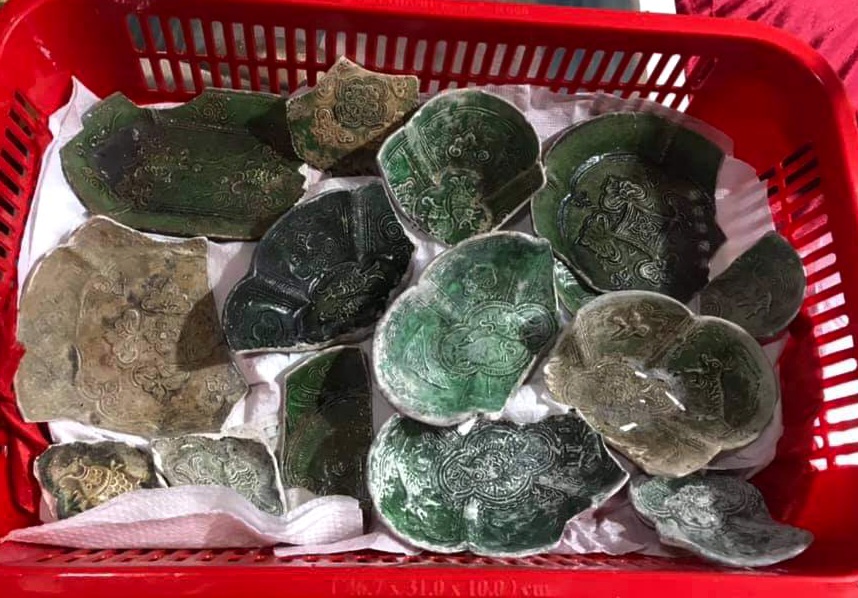 |
| Group of lead green/amber glaze cups/dishes from the Ba Ria wreck |
Two major shipwrecks from this period include:
Several key shipwrecks provide insights into this era:
By the Song period, advancements in shipbuilding and navigation allowed China to control much of the maritime trade, with Chinese junks frequently seen in Southeast Asian ports.
The most well-known Yuan Dynasty wreck is the 14th-century Sinan wreck, found in the Sea of Korea. Its cargo, bound for Japan, contained Longquan celadon and Jingdezhen Qingbai/Shufu wares.
In 2014, the Binh Chau wreck was discovered in Quang Ngai, Vietnam, with a cargo consisting of Longquan celadon, Jingdezhen Qingbai/Shufu, Fujian Qingbai/brown glaze wares, and blue-and-white wares.
During the Ming Dynasty, the Hongwu Emperor imposed a ban on foreign trade, leading to a shortage of Chinese ceramics in Southeast Asia. Thai and Vietnamese potters stepped in, producing export wares from the late 14th to 15th centuries.
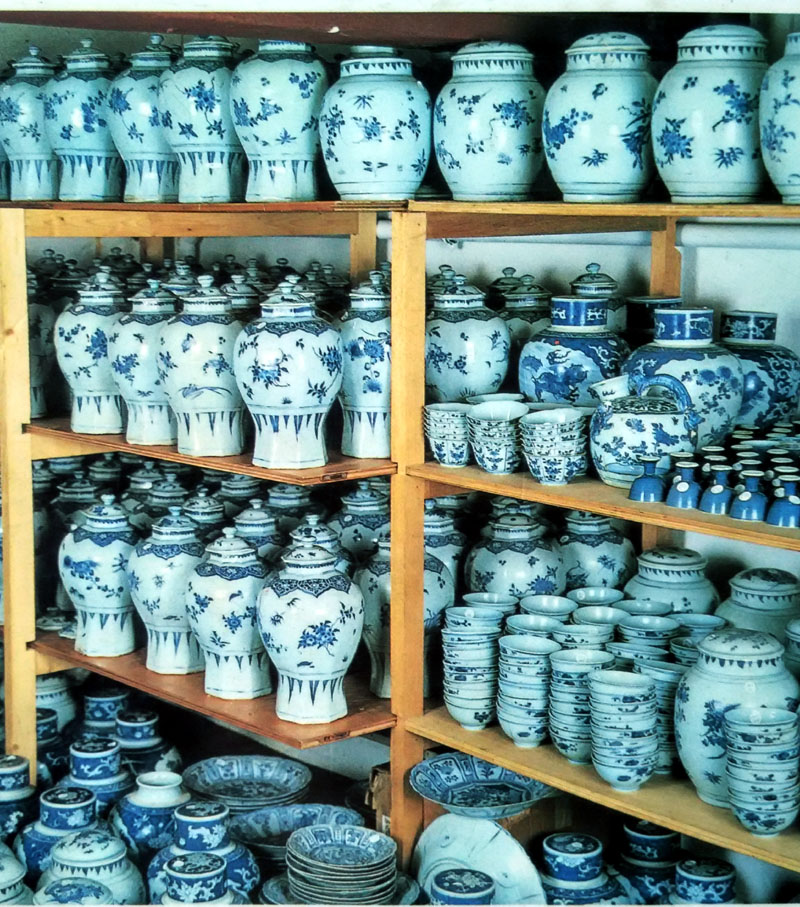 |
| Jingdezhen ceramics in Hatcher Cargo |
Qing Dynasty shipwrecks provide a detailed record of export porcelains:
With the exception of Tek Sing, which contained an enormous quantity of Dehua blue-and-white ware, these wrecks carried Jingdezhen-made porcelain tailored for export to Europe, the Middle East, and Asia.
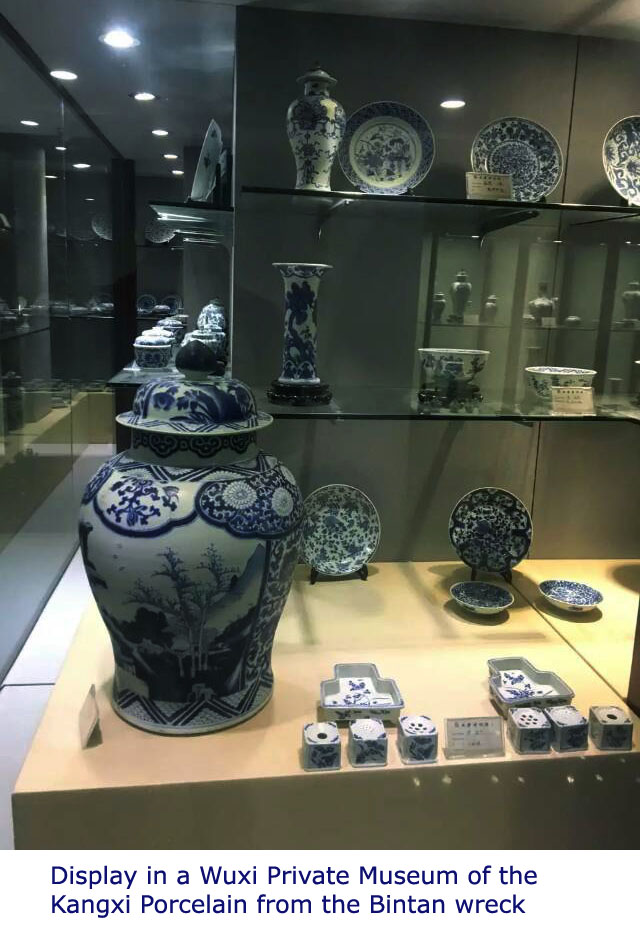 |
With at least 463 shipwrecks scattered across Indonesian waters and promising sites in central and southern Vietnam, future discoveries will undoubtedly enrich our understanding of ancient trade ceramics in Southeast Asia.
Below is a summary table listing key shipwrecks, their locations, dates, the types of ceramics recovered, and their significance.
| Name of wreck | Location | Date | Type of Ceramics | Significance of the Wreck | |
| Chinese | Southeast Asia | ||||
| Belitung wreck | Indonesia |
9th Cent.
Tang |
Changsha painted wares, some Yue Xing/ding white wares, Northern China lead green glaze wares and Guangdong green glaze wares | This is so far the earliest shipwreck found in Southeast Asia. It showed that there was already a thriving overseas trade in ancient ceramics since Tang Dynasty | |
| Tang Ba Ria wreck | Ba Ria in South Vietnam |
9th cent. Tang |
Northern kilns white wares, Northern China lead green/amber glaze wares, Changsha wares and Guangdong greenwares. | This wreck was discovered in 2019 and is another important reference source of 9th cent. Chinese trade ceramics. | |
| Tang Binh Chau weck | Quang Ngai, Central Vietnam |
Transitional Late 9th Cent. Tang/5 Dynasties |
Changsha painted wares, some Yue and Xing white wares |
This wreck is around 50 years later than that from Belitung wreck. It showed that the decorations of Changsha wares have evovled. |
|
| Cirebon wreck | Indonesia |
10th Cent.
Early Northern Song |
Yue wares and some white wares likely from Anhui kiln. | The size of the cargo is very large with ceramics amounting to more than 300,000 pieces. The types of Yue wares found is varied and is a very important souce of reference for 5 Dynasties/Early North Song Yue wares. | |
| Intan wreck | Jepara in Java Indonesia | 10th Cent. | Some quantity of Yue wares and white/qingbai wares from unknown kilns. | No comments | |
| Pulau Buaya weck | Indonesia |
1st half 12th century
Late Northern Song |
Majority celadon, Qingbai, and brown glaze wares from Guangdong. Small quantity of Jingdezhen Qingbai. | This is the only know wreck from the Northern Song period that carried mainly Guangdong ceramics. | |
| Jepara wreck | Indonesia |
1150 - 1175 A.D
Southern Song |
Fujian celadon and white wares, Longquan celadon wares | The cargo provides a good idea of the Dehua white wares, Mingqing white ware and Fujian celadon wares that were exported. There were also significant quantity of Longquan celadon wares. | |
| Kudat wreck | Sabah (Malaysia) |
1150 - 1175 A.D
Southern Song |
Fujian celadon, white/Qingbai and brown wares | The wreck is substantially looted. The 800 pieces ceramics however still provide a glimpse of the type of ceramic mix exported during the period. | |
|
Huaguang Jiao 1 wreck |
Xisha in South China sea |
1162 A.D (based on a Fujian Minqing kiln bowl with ink written cyclical date ren wu (壬午) Southern Song |
Mainly Fujian celadon/Qingbai and brown glaze wares and some Jingdezhen qingbai wares. | Around 10,000 pieces of export ceramics were recovered. The ceramic mix of this wreck is very similar to the Java wreck. | |
| Java wreck |
Java sea Indonesia |
1160/70s | Mainly Fujian celadon/Qingbai. brown glaze and iron black painted wares and some Jingdezhen qingbai wares. | Huaguang Jiao wreck which carried similar ceramic cargo provided a good basis for dating this wreck. | |
| Nanhai No. 1 |
Guangdong China |
1183 A.D (based on a Dehua white glaze jar with a ink written cylical date of gui mao (癸卯) Southern Song
|
Jingdezhen qingbai, Longquan celadon, brown and white/Qingbai from Fujian kilns, low fired lead glaze wares from Fujian Cizao kiln, Temmoku bowl from Jian kiln, celadon wares from Fujian kilns | This wreck is in good condition and is now house in Guangdong Maritime silkroad Museum (广东海上丝绸之路博物馆). It will provide important information on the types of ceramics and building and navigation technologies once fully explored but is expected to take many years. | |
| Yuan Binh Chau | Quang Ngai, Central Vietnam | 14th Cent. Late Yuan |
Longquan celadon, Jingdezhen Qingbai/shufu, Fujian Qingbai and brown glaze, Jingdezhen blue and white wares |
|
The cargo provided information on the ceramics mix for the late Yuan period. |
| Turiang | Malayasia | 1370 A.D | Mainly longquan celadon | Sisatchanalai green glaze jars and bottles. Sukhothai iron painted wares. Vietnamese iron painted wares. | The larger number of Chinese celadon suggested that Thai ceramics had yet to emerge as an important source of export ceramics. There were a small number of jars and bottles with thin green glaze which Sten Sjostrand has decided to make a distinction from the typical more thick glaze celadon. It appeared to indicate that the iron painted wares were introduced earlier than the typical Thai Sisatchanalai thicker glaze celadon wares. |
| Nanyang | Malayasia | 1380 A.D | Sisatchanalai (Sawankhalok) celadon wares | It carried probably the earliest thick glaze Sisatchanalai celadon wares (as opposed to the thin green glaze in Turiang wreck) . The interior of the celadon plates/bowls are scarred by spur marks. The use of spurs were abandoned shortly and tubular support which left a ring shape scar mark on outer base was used instead. | |
| Longquan | Malayasia | 1400 A.D | Chinese longquan celadon and white wares of unknown Chinese origin | Sisatchanalai (Sawankhalok) celadon and iron painted sukhothai wares | About 100,000 pieces were recovered, ie 15 times the volume on the Turiang. There were 40% Chinese wares, 40% celadon from Sisatchanalai, and 20% underglaze ware from Sukhothai. It showed that Thai ceramics had emerged as an important source of export ceramics. The celadon plates/bowls were fired on tubular supports and none has the spur marks on the interior base found on the earlier cealdon. |
| Pandanan | Philippines |
1st Half 15th
Cent.
Ming Interregnum |
Small quantity of Jingdezhen blue and white wares | Mainly ceramics from Central Vietnam and some Vietnamese blue and white wares | Although the number is small, it is still a valuable source of reference of Interregnum period Jingdezhen blue and white wares. |
| Royal Nanhai | Malayasia | 1460 A.D | Few Jingdeszhen blue and white and 2 Vietnamese blue and white in hidden compartment | Sisatchanalai (Sawankhalok) celadon | It showed Sisatchanalai celadon during the mature phase of production. The technique, form and decoration as demonstrated on the wares were at the very best. |
| Hoi An | Vietnam | 2nd half 15th Cent. | Small quantity of blue and white | Vietnames blue and white and enamelled wares | This is a very important wreck which provides good references for Vietnamese blue and white of the 2nd half of 15th century. There were many different forms and design and the hugh volume indicated that it was the peak of Vietnamese export ceramics. |
| Lena Shoal | Philippines |
2nd Half 15th
Cent.
Ming Hongzhi |
Mainly Blue and white, small number of Longquan celadon | Small number of Vietnamese blue and white and Thai celadon | Hongzhi period is most probably the starting point which Jingdezhen resumed production of increasing large number of blue and white for overseas market. This wreck carried blue and white wares with quite a wide arrange of motifs and design. It is a good source of reference for understanding Hongzhi blue and white wares. |
| Xuande | Malayasia | 1540 A.D | 170 Chinese Jiajing blue-and-white ceramics | 30 iron painted wares of late style from Sukothai and Sisatchanalai | The relatively small number of Thai ceramics and larger number of Chinese blue and white very much confirmed the re-emergence of chinese ceramics as the favoured export wares. There was no Thai celadon found in the wreck. It might also be an indication of the overseas consumers preference for decorated wares over monochrome. |
| Singtai | Malayasia | 1550 A.D | Small number of Sukhothai and Sisatchanalai iron-pained wares | It might be a further evidence of overseas consumers preference for decorated wares over monochrome celadon wares By now, Chinese blue and white was the most mportant export ceramics as shown in the below wrecks. | |
| Belanakan | Indonesia |
Mid 16th Cent.
Ming Jiajing/Longqing |
Jingdezhen blue and white wares | A source of reference for Jingdezhen Blue and white wares. | |
| San Isidro | Philippines |
Mid 16th Cent.
Ming Jiajing |
Swatow blue and white | A good source of reference for early types of Swatow blue and white wares | |
| Nan Ao No. 1 | Southern China |
Mid/3rd Qtr 16th Cent.
Ming Jiajing/Wanli |
Mainly Swatow and some Jingdezhen blue and white | Another wreck which can serve as a reference for early Swatow blue and white wares. | |
| San Diego | Philippines |
1600 A.D
Ming Wanli |
Jingdezhen blue and white and small number of swatow wares | It is a reference for some of the kraak wares that were produced to meet overseas demand. | |
| Binh Thuan | Vietnam |
Early 17th Cent.
Ming Wanli |
Swatow blue and white and enamelled wares | This wreck is a good source of reference for Swatow wares that were produced during the Wanli and later period. The composition of some of them is similar to Jingdezhen kraak blue and white wares. | |
| Batam | Indonesia |
Early 17th Cent.
Ming Wanli |
Swatow blue and white and enamelled wares |
This wreck is a good source of reference for Swatow wares that were produced during the Wanli period. |
|
| Wanli | Malaysia |
1st Half 17th
Cent.
Ming Tianqi |
Jingdezhen blue and white | This is an important wreck for those who are interested to identify Ming Tianqi blue and white. This is the start of the transitional phase of change of style of Late Ming to Early Qing blue and white. | |
| Hatcher | Indonesia |
1st Half 17th
Cent.
Ming Chongzhen |
JIngdezhen blue and white | Another good source of reference in identifying transitional blue and white wares. | |
| Vung Tau | Vietnam |
2nd half 17th
Cent.
Qing Kangxi |
Mainly Jingdezhen and small number of swatow blue and white | A source of reference of Jingdezhen export wares of the Mid Kangxi period to Europe | |
| Bintan | Indonesia |
1st half of 18th
Cent. Qing Kangxi |
Mainly Jingdezhen blue and white/enamelled wares. Small quantity of sancai wares |
A source of reference of Jingdezhen export wares of the late Kangxi period to Europe |
|
| Ca Mau | Vietnam |
1st half 18th
Cent.
Qing Yongzheng |
Jingdezhen blue and white and small nukmber of shiwan sancai wares | A good source of reference of late Kangxi/early Yongzheng Jingdezhen export ceramics wares to Europe. | |
| Nanking (Geldermaisen) | Indonesia |
Mid 18th Cent.
Qing Qianlong |
Jingdezhen blue and white and enamelled wares | A good source of reference of Mid Qianlong Jingdezen export ceramics wares to Europe | |
| Diana | Malaysia |
1817 A.D
Qing Jiaqing |
Jingdezhen blue and hwite | A good source of reference of Qing Jiaqing period Jingdezhen export ceramics wares to Europe | |
| Tek Sing | Indonesia |
1821 A.D
Qing Daoguang |
Dehua or Dehua type blue and white, some Fujian brown glaze wares and Yixing teapots | A source of reference for early 19th century Dehua blue and white wares. The huge quantity amountng to more than 350,000 pieces indicated that the demand for such ceramics was substantial in Southeast Asia. In fact, such Dehua blue and whites were found in large quantity in the ancient Vietnamese port of Hoi an. | |
| Desaru | Malaysia | +/- 1840 A.D | Mainly Jingdezhen blue and white, some Fujian blue and white and Yixing teapots | A reference source of late Daoguang period blue and white for Southeast Asia market | |
Written by: NK Koh (18 Dec 2010), updated (12 Jan 2016), 2 Sep 2021, 7 Feb 2025